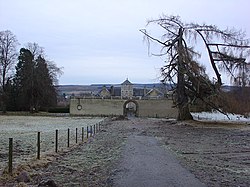| Battle of Alltan-Beath | |||||||
|---|---|---|---|---|---|---|---|
| Part of the Scottish clan wars | |||||||
 Foulis Castle where Donald Mackay was imprisoned after the Battle of Alltan-Beath | |||||||
| |||||||
| Belligerents | |||||||
| Clan Sutherland (Supporters of John Gordon, 11th Earl of Sutherland) | Clan Mackay | ||||||
| Commanders and leaders | |||||||
| Hutcheon Murray of Aberscross Gilbert Gordon of Garty | Donald Mackay, 11th of Strathnaver | ||||||
| Strength | |||||||
| Unknown | "A company of men" | ||||||
| Casualties and losses | |||||||
| William Sutherland (KIA) | John MacIan-MacAngus (KIA) | ||||||
The Battle of Alltan-Beath, also known as the Battle of Ailtan-Beath, was a Scottish clan battle said to have taken place in 1542 in the village of Knockarthur (or Knockartel), in Sutherland, in the Scottish Highlands. It was fought between men of the Clan Mackay and men of the Clan Sutherland whose chiefs were the Gordon, Earls of Sutherland.